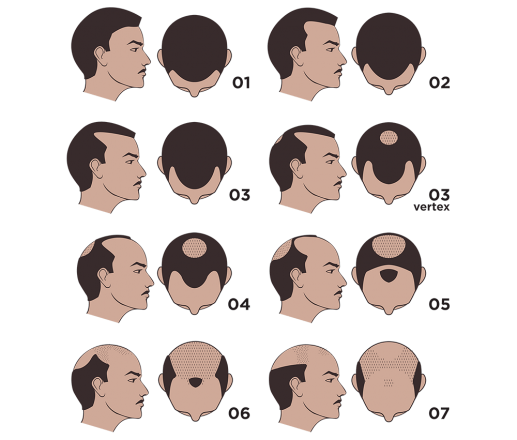Male Pattern Hair Loss
Male Pattern Baldness is the most common cause of hair loss seen in males, also know as Androgenetic Alopecia or Genetic Hair Loss. Male Pattern Baldness is caused by the interaction between Androgen Receptors, at the base of hair follicles, and Dihydrotestosterone (DHT). The amount of Androgen Receptors and DHT is genetically unique to each person. The numbers and locations of hair follicles that are susceptible is determined by the genes inherited from both or one parent. Androgen Receptors are only found at the front and/or the crown/vertex of the scalp, but not found ever found on the sides or back of the scalp.
The effect DHT has on your hair follicle is to alter the natural hair cycle, which consists of a Growth Phase, Transition Phase and Resting Phase. During the growth cycle each hair will grow approximately half an inch and this phase will last 3-5 years on average. At the end of the growth phase we will see a 10 day Transition Phase, before the hair enters a Resting Phase for around 3 months. When the Growth Phase restarts, the existing hair will be shed and a new one will grow in its place. Pattern Baldness will cause the Growth Phase to ongoingly become shorter in length, and the Resting Phase longer. Eventually the hair follicle will cease to grow new hairs.
Male Pattern Baldness is categorized by the Norwood scale, which can be seen below. Male Pattern Baldness typically follows a 7-stage process from early hair loss until complete hair loss in the non-permanent areas. When it comes to treating Male Pattern Baldness, the earlier on the scale you start your treatment, the more likely you are to be able to limit your future Hair Loss.
Men who suffer from Male Pattern Baldness are able to take Finasteride and Minoxidil, the only 2 FDA-Approved Medications to combat Hair Loss. For more information on the available medications for Male Pattern Baldness, please visit Prescription Medications.

